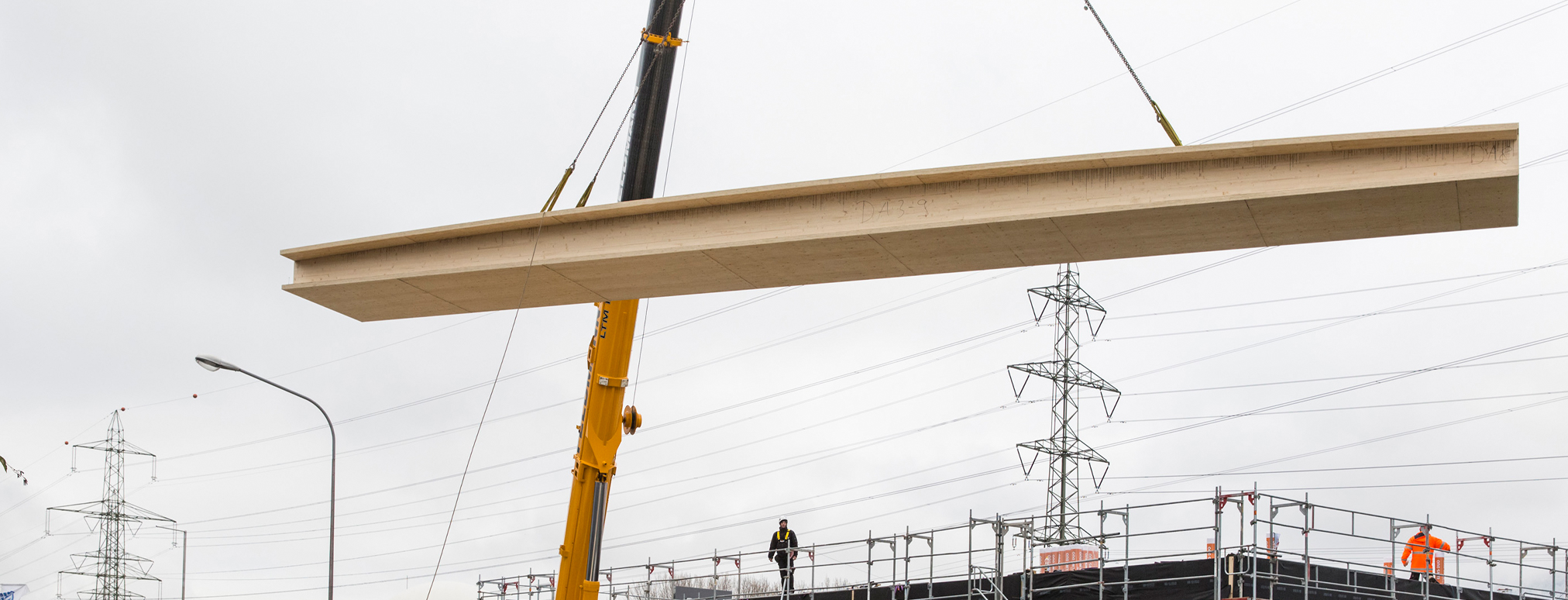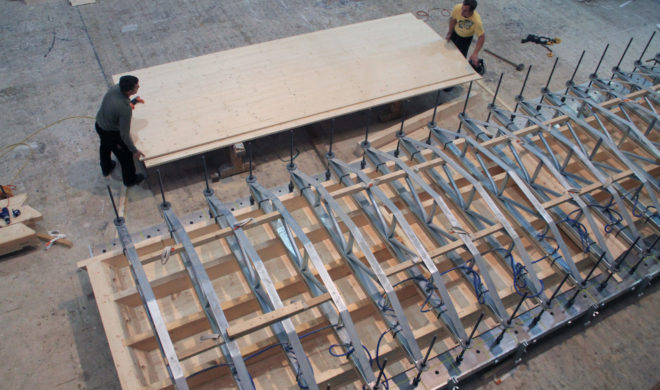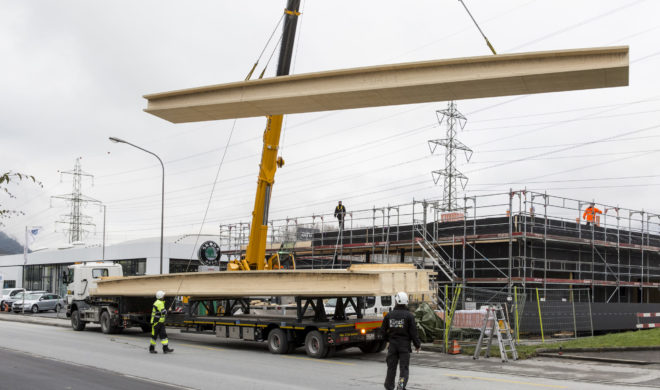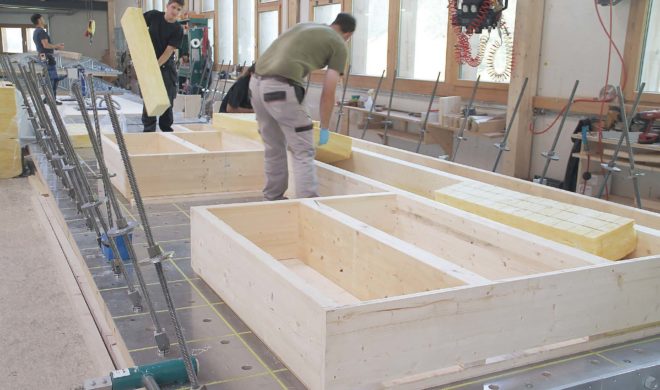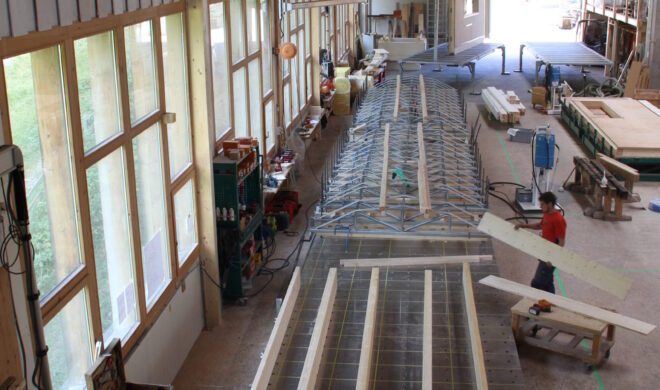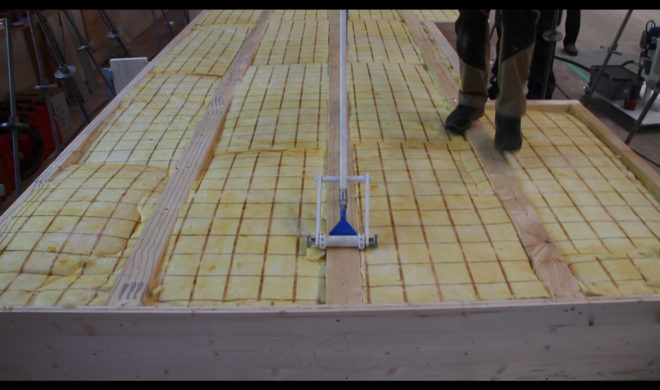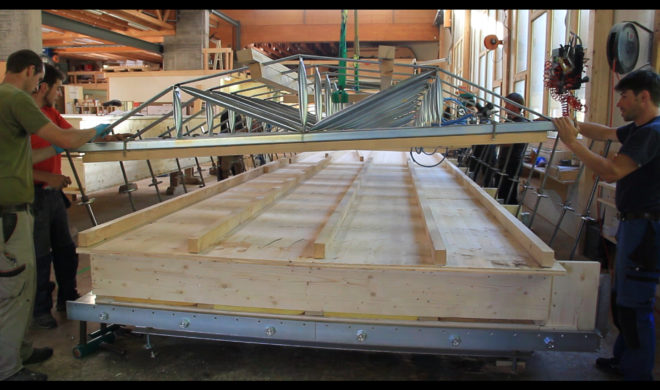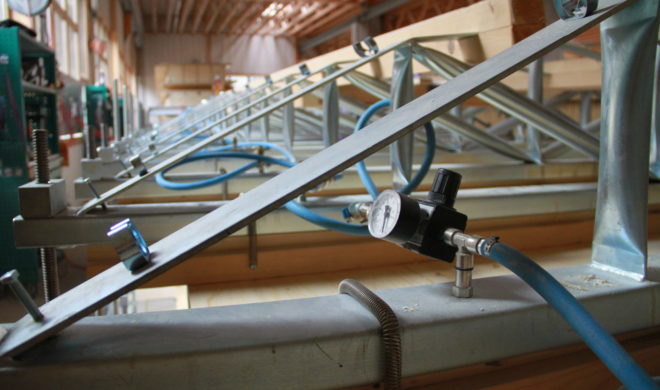Connecting with Adhesives
Fasteners do not always have to be used to manufacture wooden construction elements. They can also be glued. Thanks to a pneumatic pressing principle, box girder elements for use on attics and false ceilings can be manufactured economically with adhesive. The article gives an introduction to this production method.
Der Zimmermann, Ausgabe 12, 2017
Automatic Google-Translation from the German Original:
The advantages of gluing conventional beam structures on both sides with wood-based panels to form so-called box elements or hollow boxes are diverse and diverse. Statically, such products have an improved vibration stiffness and enable larger spans of the ceilings. In addition, the cross-section of the floor slab can be reduced by around a third in height. Compared to solid floors, the cavities in the element allow sufficient space for heat and sound insulation or electrical and ventilation installations. For this purpose, the lower three-layer board is often glued in visual quality, which is also aesthetically pleasing. Especially since the new production technology works without screws.
From an engineering point of view, box elements are no longer to be calculated as beam structures, but as surface structures. Thanks to the adhesive connection between the panels and beams, not only can the cross-section of the beams used be reduced, but the vibration rigidity of the element is also improved. This enables larger spans with lower element cross-sections.
Traditionally Screws were used to create pressure
Box elements have also been used for larger structures. The problem, however, has always been the complicated production, which required mastering wood, gluing and pressing techniques for a single product. Up until now, box elements were mostly produced using screw pressing. The pressure on the glue joint that is necessary during the hardening of the glue is brought about by special cup screws attached at precisely prescribed intervals. Due to the nature of the screws and the tight spacing, production takes time and expensive materials. In addition, the pressing pressure cannot be measured. Possible restoring forces from the wood can even cancel this out, as screws do not re-press. In addition, the element must be turned to the second side for screwing, which can easily damage the glue line.
Developed together with customers
A new pressing technique should now compensate for these disadvantages. At the request of customers, the Swiss machine manufacturer Woodtec Fankhauser GmbH worked out a system that is tailored to the needs of timber construction companies. The company already has experience with box elements, as these have been produced by customers in their vacuum presses for almost 15 years. However, these presses are designed for panel and cross laminated timber production and are not flexible enough to be operated economically by many commercial enterprises.
The new pressing device is integrated into the existing element construction table. This means that the press system does not take up any additional space in the hall and is only used when it is actually necessary to press. Otherwise, conventional wooden frame elements are produced on the element construction table. Based on customer experience, the company estimates that around 30 percent of the time is spent on box elements and the rest on normal walls and non-glued ceilings.
Now it is pressed pneumatically
The pressing method is based on the principle of pneumatic hose pressing. The box element is glued and assembled on the element construction table. Press brackets are then placed at intervals of 50 cm and anchored by means of expansion anchors on both sides of the box in the perforated grid of the structural element. On the underside of the press bracket there are hoses that pneumatically press onto the box element.
This has the advantage that the pressure that should be applied to the element can be precisely defined and is automatically re-pressed. This means that the pressing pressure is kept constant over the entire duration of the pressing. In addition to other important production parameters such as wood moisture, hall temperature or planing quality, this is the decisive point to guarantee correct bonding to the engineer and the client.
Connecting with Adhesives
Production in Europe
Box elements can be manufactured in the EU according to Eurocode 5 and are subject to the panel construction standard there. In Germany, the Zimmererei Sieveke GmbH (Lohne, D) is the first manufacturer to produce box elements with the press system. In Switzerland, twelve companies are now producing with the system. In Switzerland, however, box elements can be manufactured without monitoring or a standard concept. The stages for the glue construction permit, external and internal monitoring in Germany are associated with little effort. Woodtec Fankhauser GmbH is also happy to provide customers and interested parties with advice and assistance.
Not just for the multi-storey building
Some objects have already been built with hollow box elements produced in this way, multi-storey buildings such as a six-story staff building in Lenzerheide, Switzerland, or engineering structures such as an exhibition hall with 20 m freely spanned box elements.
The advantages of box elements as false ceilings can be fully exploited, especially in multi-storey buildings. The entire construction from the foundation can be prefabricated on the element construction table including the pressing device, so that the added value remains in operation.
It doesn’t have to go high, even single-family houses can be prefabricated with glued box girder elements. The glued box girder elements can also show their static, energetic and acoustic advantages in smaller buildings. In single-family house construction, three-layer panels are often used for the ceilings on the lower side, which can be used as a visible surface without further processing. Thanks to the adhesive connection, these do not have any screw holes and still support the static.
More News
Show All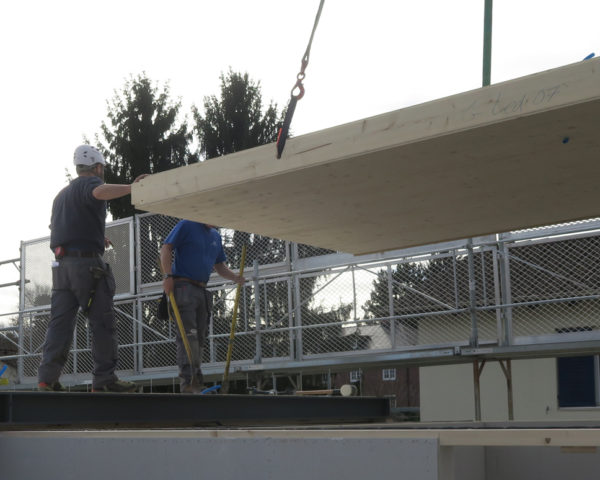
Added Storeys and Extensions
With increasing urbanization and the legislative measures against urban spraw…

Connecting with Adhesives
Fasteners do not always have to be used to manufacture wooden construction el…
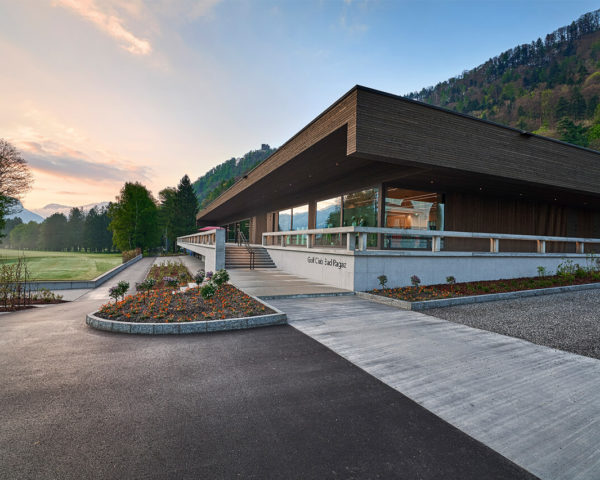
Glued Box Girders – Completely Without Screws
Glued box girders for roofs and ceilings with a larger span
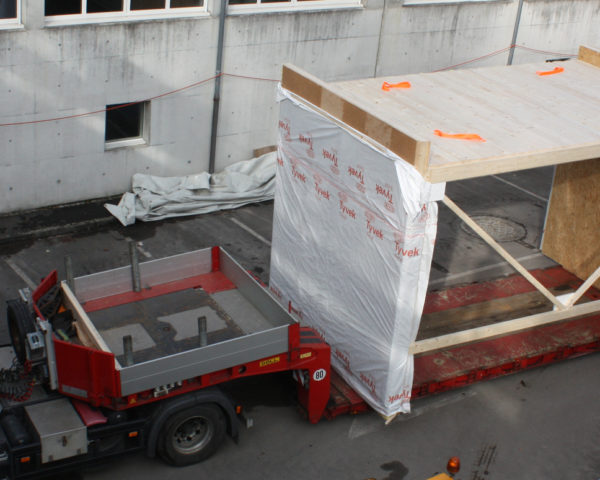
Timber for Athletes
Whether sprinting, hurdling, long jump or javelin throwing – thanks to ribbed…
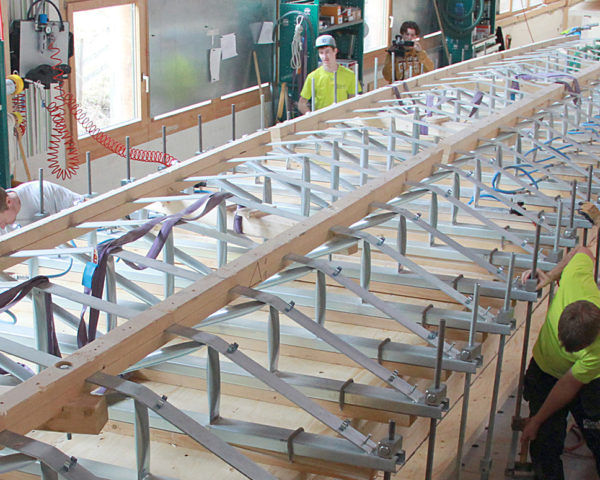
The structures of the future
Glued Box Girders with 21 m span for exposition hall
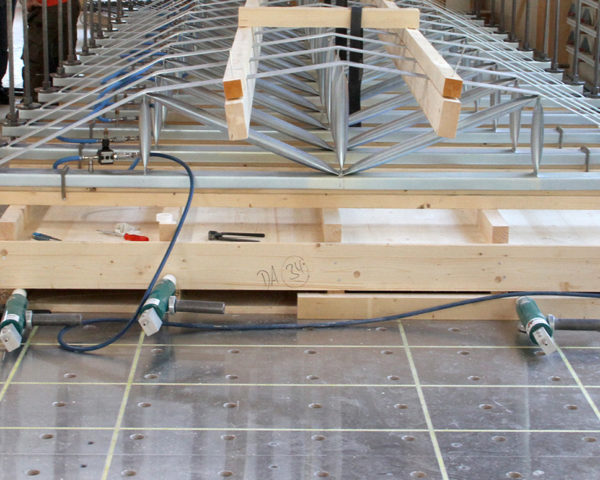
Pneumatically Pressed Box Girders
With their energetic, static and aesthetic properties, box girders are popula…
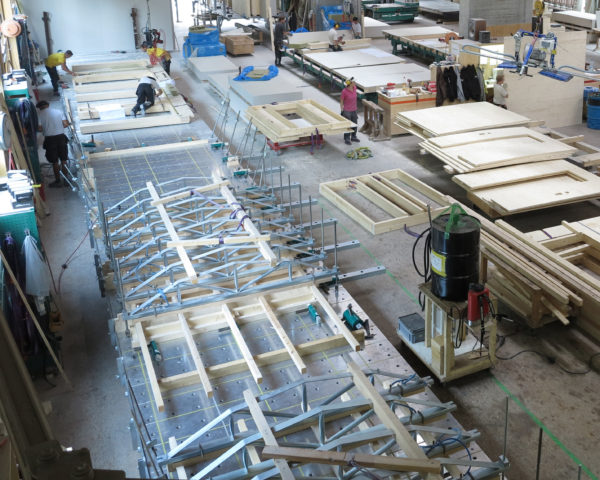
Pneumatic Pressing Technology
A new production method changes the production of box girder elements for use…
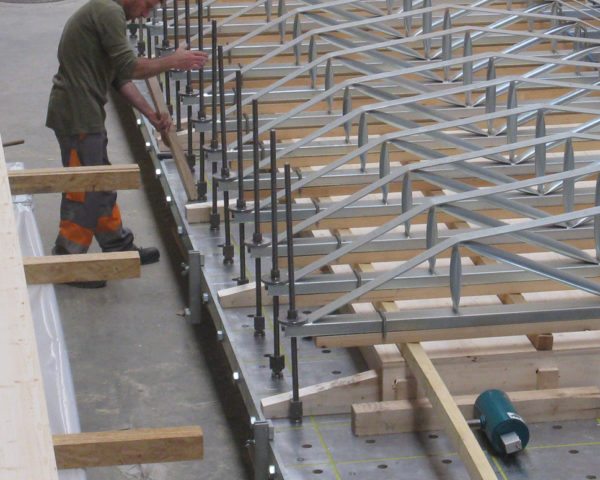
Timber and Adhesive
The latest trend in timber construction is the gluing of load-bearing wooden …
